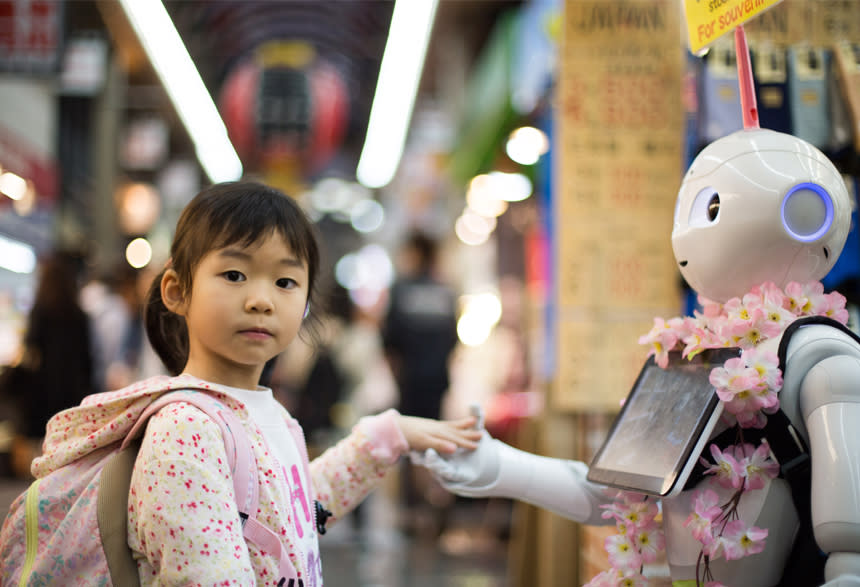
There’s a lot of anxious chatter around the question, “Which jobs will robots take?” Please join me instead in a conversation that asks: “Given emerging technologies, how can we craft valuable, excellent jobs for people?” With the impressive advances in AI and machine learning, it would be a damned waste of a crisis if we didn’t look at this massive transformation as a chance to re-design the whole thing. Instead of a defensive and fearful reaction—“First they came for the manufacturers…”—I propose an assertive and optimistic stand for the role of people in our business lives.
We need to find the right division of labor between people and “intelligent systems.” To put human needs first, we need to ask: “What are people for?”
Given emerging technologies, how can we craft valuable, excellent jobs for people?
Think about your own interactions with big companies, and any frustrating time when all you wanted was a person, please! That is what people are for: the mixture of empathy and judgment it takes to resolve an ambiguous situation. Algorithms can’t bend the rules or make someone feel special who feels he or she has been wronged.
The first, obvious point is that robots (for now) make terrible people. Robots are uncanny. The flip-side, which deserves more attention, is that people make terrible robots. And yet, we are often given robot jobs. Jobs for robots should be the ones we don’t want, because they are mindless, meaningless, repetitive, or dangerous. Automation is eliminating jobs. It has the promise of eliminating the crap jobs first. Good riddance: These are jobs which aren’t good for us and which we’re not good at.
There are reasons for optimism about this transition, but they require that we assume something fundamental about people, especially those in customer-facing roles—that they can bring unique value to business if we ask them to. If we only treat people as a cost center, we will seek ways to automate away their jobs for the sake of savings, and probably tolerate a worse customer experience in the bargain. But if we think of the people on the front lines as creators of value—of revenue and customer loyalty—then we will look to define excellent jobs for them, supported by remarkable technologies. This will require vision and will. Smart, humanist companies will drive it.
In the short term, we can be optimistic because of demographic trends. The wave of baby boomers entering retirement comes at a good time. A huge number of older employees, those least equipped to navigate fundamental transformation in their jobs, are leaving work voluntarily and organically.
To put human needs first, we need to ask: “What are people for?”
We have spoken with and worked with companies in many industries who see the opportunity to ride a natural wave of attrition to a younger and slightly smaller workforce. On the other side of this shift will be digitally supported teams doing the jobs that we are now in the process of defining. EPAM Continuum helps big companies navigate these tectonic shifts, which are part of the broader “digital transformation.”
We were able to help transform the call-center model for UnitedHealthcare, the nation’s largest health insurer. We discovered untapped potential in calls to customer service and leveraged the call-center as a clinical resource to 24 million stressed patients. We integrated IT and IVR tools to enable call-center employees to deliver a great customer experience, using data to flip to a proactive model oriented around patients most probable needs. We changed the performance metrics to measure the value of compassionate, knowledgeable agents. Projects like this prove the tight connection between great customer experiences and re-designed jobs that are more fulfilling and impactful.
Longer term, the history of work suggests that technological advances will help create entirely new jobs. It has happened again and again. A century ago, one third of Americans worked on farms. Today that number is less than 2%. People found other, new jobs (like mine, and probably yours).
At EPAM Continuum, we're drawing a roadmap to a future of work that recognizes this important truth: As technology makes more customer touchpoints self-service or automated, the remaining human interactions come into higher contrast, and often are higher stakes.
Customers usually find they need a person after their frictionless self-service experience slams into a dead end. Systems fail, and people are for recovery. When things are going well, we can put technology in the hands of customers, and our goal is for things to feel magical. But when the experience starts to fall apart, our goal is for people to intervene and recover in a way that feels heroic. We need to equip frontline employees with the tools and information to appear to be heroic, without actually putting too heavy a burden on them.
In many jobs, heroism is an aspiration, but in some it explicitly is the job. No workers come to the rescue more heroically than first responders. EPAM Continuum worked with fire, police, and EMS to envision the future of first response. We proposed a model for the right way to integrate new technologies into these jobs—technologies for sensing and drawing data from the world, for processing that data and making it useful, and for supporting dynamic teamwork in dangerous settings. This work shows how we might augment first responders’ awareness of dangers, their orientation to a chaotic situation, and their decision-making abilities.
The answer to the question “Robots or people?” is “Robots for people.”
Teamwork is an essential part of work, so a well-designed job cannot be considered in isolation. A systems-view ethos considers the larger assembly of tasks and responsibilities. Today, that includes determining how people and computers can best work together. There are some encouraging and some cautionary examples. The authors of the book Prediction Machines point out that in the field of oncology, the highest accuracy rate in cancer detection comes when people and algorithms work together, higher than either working alone.
This example suggests that robots won’t become the oncologists, but that because people and smart systems make different kinds of mistakes, they can be effective teammates. However, Nicholas Carr outlines persuasively in his book The Glass Cage, that sharing work, when done wrong, increases the rate of human mistakes. Citing the example of airline pilots, Carr explains that the wrong way to share work is to automate the everyday tasks and expect the human to intervene in case of emergencies. You can’t give the everyday work to a robot and ask a human to take over in an emergency. Without the everyday practice, we’re not prepared and our skills erode.
Rather than letting the automation of labor incrementally overtake us, companies should anticipate and envision a transformation of labor that includes the augmentation of human capacities, putting technical advances in the service of people. Our lighthouse should be a vision for the transformation—not the automation—of work. Shifting our thinking about employees from cost to value makes it easier to see the parallel shift of work from menial to meaningful. During a brainstorming session, I recently heard our client Heather Figallo, the head of innovation at Southwest Airlines, ask provocatively about the new job to be done by clinical family therapists in airports. When your flight is cancelled, a robot can re-route you. But if you are about to miss your father’s funeral, that’s just not good enough. Heather recognizes our current opportunity to create higher-value jobs.
This is advocacy, not prediction: The humanist future is one where robots assist in the emergence of excellent jobs. The answer to the question “Robots or people?” is “Robots for people.”
Photo by Andy Kelly on Unsplash




